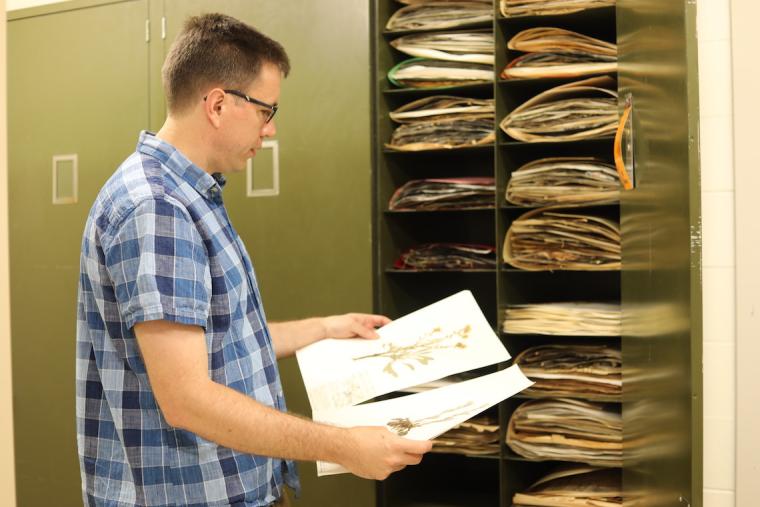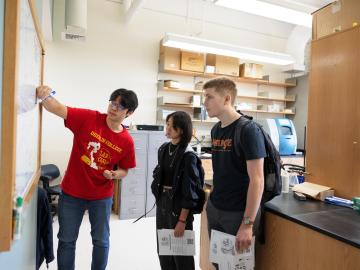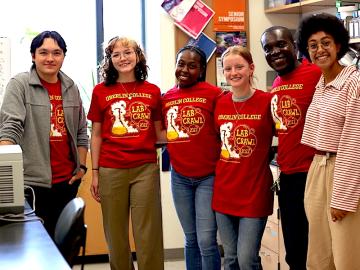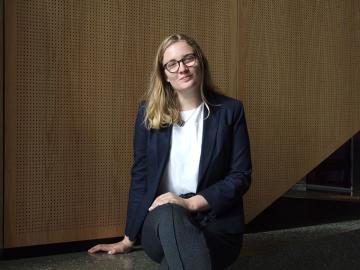Reborn Herbarium is a Boon to Biodiversity
July 19, 2018
Amanda Nagy

Since arriving at Oberlin in 2007, Professor of Biology Michael Moore has been collecting plant species from all over North America, but mostly from the Chihuahuan Desert, which encompasses New Mexico, West Texas, and parts of North Central Mexico. Up until recently, he’s preserved and stored these species with the intent of donating them to nearby museums.
“I would keep specimens in what amounted to a utility closet, and they were fine, but I never mounted them. I kept collecting, then I got tenure, and I got to thinking about what I wanted to do, so I decided it would be a good idea to have these housed permanently at Oberlin,” says Moore, a leader in the field of plant systematics—a science that studies the origin and evolution of plant diversity.
This summer, with the help of some leftover funding from a National Science Foundation grant, Moore began installing an herbarium in the Science Center to properly archive his roughly 4,000 specimens right here on campus.
“When we go out in the field we collect plant specimens, and we collect enough material to get duplicates so we can share with another herbarium and so I can keep some for myself. It’s a good way to introduce students to plant diversity and plant taxonomy and systematics. It’s also a really good introduction into biodiversity—not just plants, but collections in general,” Moore says.
While an herbarium is surprisingly low-tech, the value to research and learning is immeasurable.
“There’s a real resurgence nationwide on objects-based teaching and this is another object,” Moore says. “People really connect better with physical things rather than abstract things. I plan to incorporate this into student research, and I’m hoping to get it involved in my upper-level class on plant systematics.”

The herbarium consists of 10 large cabinets in what used to be the hazardous materials room in the biology wing of the Science Center. Moore and his students will take the preserved plants and mount them on high-quality archival card stock. Everything he has collected has digitized collections data associated with it, and he hopes to eventually make both the specimens and their data publicly available.
“Mounted samples can last for centuries. They form a permanent record of the things we’ve collected. They’re valuable for understanding the evolution of what we call morphology— roughly speaking, the anatomy of plants. They can also help to confirm whether species are new or not.”
This particular collection of plants is new to Oberlin, but the idea of an herbarium certainly isn’t. In fact, Oberlin once boasted an herbarium with more than 200,000 specimens. The collection was sold off in two events, first in the 1960s to Ohio State University, and next in the 1990s to Miami University. When Moore arrived, all that was left were a couple of cabinets and some odds and ends.
Moore announced his plans a couple months ago on Twitter, and news in the plant research community went viral. “Immediately, everyone was offering specimens as gifts” to the new herbarium, Moore says. “The director of the herbarium at Miami University isn’t even on Twitter, and the next day he sent an email asking if I’d like duplicates from our old collection.”
Without a strong advocate, Moore explains, collections such as these are in jeopardy.
“Most people don’t understand why we need to do this. It’s a valid question,” he says. “In these collections are the biological heritage of the earth. A photo cannot capture the anatomy of an organism. I want to know the internal anatomy—what the seed looks like on the inside. There’s no substitute in this day and age.
“Second, you can document in space and time when and where something lived. It is because of biological collections that have been made in New England for the last 200 years that we know that plants are now flowering earlier than they were 200 years ago. It is a direct impact of global warming.”
The value to Oberlin is pedagogical. The collection gives students the opportunity to work with plants they otherwise wouldn’t see, and it has the potential to get more people interested in studying biodiversity and botany.
“Personally, I worry a lot about the growing disconnect between modern folks and nature,” Moore says. “If I were a professor at Oberlin 100 years ago, all of my students would know what an oak tree was. That is a rare thing these days. There are real problems with that in terms of how we treat nature and what it means for conservation in the long run. If this is one way I can get more students interested in studying nature, that’s great for me.”
Tags:
You may also like…
Friday Afternoon with Lab Crawl
October 30, 2023
This year’s Lab Crawl drew what may be the largest crowd in the event’s illustrious history, with some 500 students and dozens of faculty taking part. Missed out on the excitement? It looked something like this.
Lab Crawl: It’s Not Just for Scientists
October 24, 2023
Oct. 27 open house highlights research across the sciences—and just about everywhere else.
In the Path of Disaster
August 28, 2023
Monica Dix travels to a hub of natural calamity to probe its risks and resilience.


